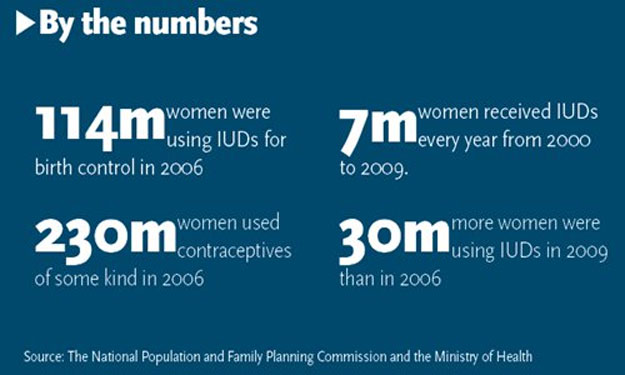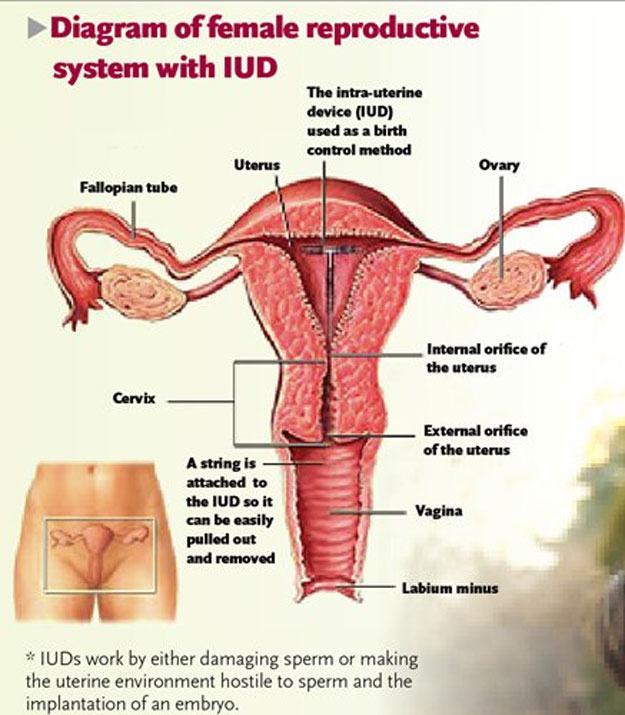China offers free removal of birth control implants after scrapping one-child policy
Women were coerced into installing intra-uterine devices across China from the 1980s

Women were coerced into installing intra-uterine devices across China starting from the 1980s as a family planning method. PHOTO: Reuters
The devices can cause health issues in the long term
Many are enduring another painful process trying to have the device removed in order to have more children under the new policy.
"It was painful… and it was kind of like an abortion," Xiang Lan said, describing her surgery last year in which a doctor used forceps to remove the intra-uterine device (IUD) that had been in her uterus for more than 30 years.
Xiang was lucky compared with many other women who choose to have their IUDs removed after hitting menopause. Her operation went well and she went back to work after taking three days off.
Born again: baby boom after China ends one-child rule
But what 67-year-old Chang Suchun went through to get rid of her IUD was pure suffering. The device had become embedded into her uterus after being there for more than 25 years. She writhed in pain as the doctor tried to pull it out. She could not tell how long the operation lasted and she passed out when the device finally came out, accompanied by gushing blood.
Statistics from the National Health and Family Planning Commission (NHFPC) showed that up to 2006, 114 million out of the 230 million Chinese women who used contraception chose the IUD.
The 2010 NHFPC yearbook revealed that 30 to 40 percent of contraceptive operations since 1983 were IUD surgeries. More than 7.81 million IUDs were implanted from 2000 to 2009.
According to a guideline released by the American Congress of Obstetricians and Gynecologists, IUDs are a safe, effective and reversible form of contraception. But according to a NHFPC report on the effectiveness of IUDs in China based on 120,000 cases from 2000 to 2005, the accumulated defect rate reached 23.31 per cent.
The horrors of China’s one-child policy
Zhu Chuzhu, an expert on demography wrote in her book on the influence of the family planning policy on women that some local governments were eager to accomplish "their mission related to the family planning policy, including contraception operations," and this is why China has a particularly high rate of IUD usage and related complication.
Internal affairs
Hai Qin (pseudonym), a woman living in Anhui Province who lost her only child, said that most mothers at her age, especially those living in suburban and rural areas, were asked to accept a IUD operation soon after they stop breastfeeding.
Thirteen female lawyers from Henan Province, Beijing and Shenzhen sent a joint letter to the NHFPC in December 2012, asking for an end to this practice, news portal ifeng.com reported. By the time they started going through menopause years later, some of the women who had an IUD had actually forgotten about the device in their bodies.
"Women need to remove the IUD within six months after menopause begins. The uterus will gradually shrink after the menopause and IUD may cause pain or endometritis (inflammation of the uterus lining caused by an infection)," Wang Yu, an obstetrician and gynecologist from Shengjing Hospital of China Medical University in Shenyang, Northeast China's Liaoning Province, said.
China's new two-child policy law takes effect
Some IUDs contain copper, which can affect MRI scans on the waist and pelvis cavity, said Wang. "There may be some complications during the operation to remove the IUD, including bleeding, pain, infections, perforation of uterus or the IUD breaking," said Wang, adding that most of these operations are safe.
Wang also mentioned that due to these complications, it is not unusual to see patients suffering from nausea, arrhythmia, chest pains or even fainting.
"The first IUDs used in the 1980s were rings made of stainless steel and they were abandoned as they were inefficient. Hospitals then began to introduce new types of IUDs which contain copper," Wang said.
Dr Kun Ka-yan, a private obstetric specialist in Hong Kong was quoted by the South China Morning Post as saying that the stainless steel IUDs needed follow-up checks to monitor any changes and the development of the body while the device is inside, but many people failed to have the checks which resulted in health problems.
Little information
Sun Xiaoming, an expert on demography at the Nanjing University of Posts and Telecommunications, said that around 25 per cent of the women living in rural areas never had their IUDs removed.
China to limit family size for up to 30 years, despite concerns
The family planning services offered by local governments at the grass-roots level used to stress reducing fertility and did not bother to tell women to eventually remove the devices, said Sun, adding that "[Many women] missed the best time [to remove their IUD]."
Women of childbearing age enjoy four free services as part of the family planning policy, including taking the IUD out, but only those who meet certain requirements, women who are allowed to have another child or cannot continue to have the IUD for health reasons. Those who do not meet this requirement cannot have their IUDs removed for free.
Hai said that women who lose their only child can also get a free operation to remove the IUD but the suffering they feel is not only physical but also mental.
"Many of these women are around 40 years old or even 45. They have to stand the pain during the removal operation, get pregnant and some may have several miscarriages," said Hai.
Chen Suwen, an obstetrician and gynecologist from Beijing Obstetrics and Gynecology Hospital was quoted by The Beijing News as saying that the medical services in some places are poor and many women who cannot get their IUD removed locally come to Beijing. Scans can cost more than 1,000 yuan ($144) and follow-up treatments can cost even more.
Sun said that these fees are not included in most places' medical insurance policies and many poor women cannot afford the operation.
Sun conducted a survey into the main problems and requirements of women after their menopause for the NHFPC, during which he found that the average fee to remove the IUD is around 100 to 150 yuan, around 150 to 200 yuan for those whose have uterine damage, and 1,000 to 3,000 yuan for those whose IUDs have become embedded in their uterine wall.
Sun and his team estimate that there will be about 26 million women in China that need to have an IUD removal operation in the next 10 years after hitting menopause, which could cost these women around 2.6 billion yuan in total.


Dealing with the legacy
Some local governments in the country's more developed regions are taking action.
A district in Yancheng, East China's Jiangsu Province has included IUD removal operations into their family planning service and notify those who are registered with their system to have the operation after they begin menopause, Xinhua Daily reported.
People working in the family planning bureau in Jinan, East China's Shandong Province have also conducted a series of activities on this issue, including publicising this kind of information and offering women operations, according to The Beijing News.
Sun said that the central government has also attached importance to the IUD issue in recent years and has set aside funds to deal with it.
"But the obstacle lies in how to get local governments to push the publicity and operations actively, especially in central and western regions," Sun said, mentioning that these regions have promoted IUD removal operations among women of childbearing age after China announced it would get rid of the one-child policy in October 2015.
The NHFPC also said in December 2016 that local governments would offer free operations to remove IUDs for more than 18 million women who want to have a second child.
"We should not only pay attention to improving medical services for those who want to remove the IUD to have a second child. Women who received the IUD for our family planning policy and entered menopause should not be forgotten. It's our responsibility," Sun said.
This article originally appeared on Global Times.



















COMMENTS
Comments are moderated and generally will be posted if they are on-topic and not abusive.
For more information, please see our Comments FAQ